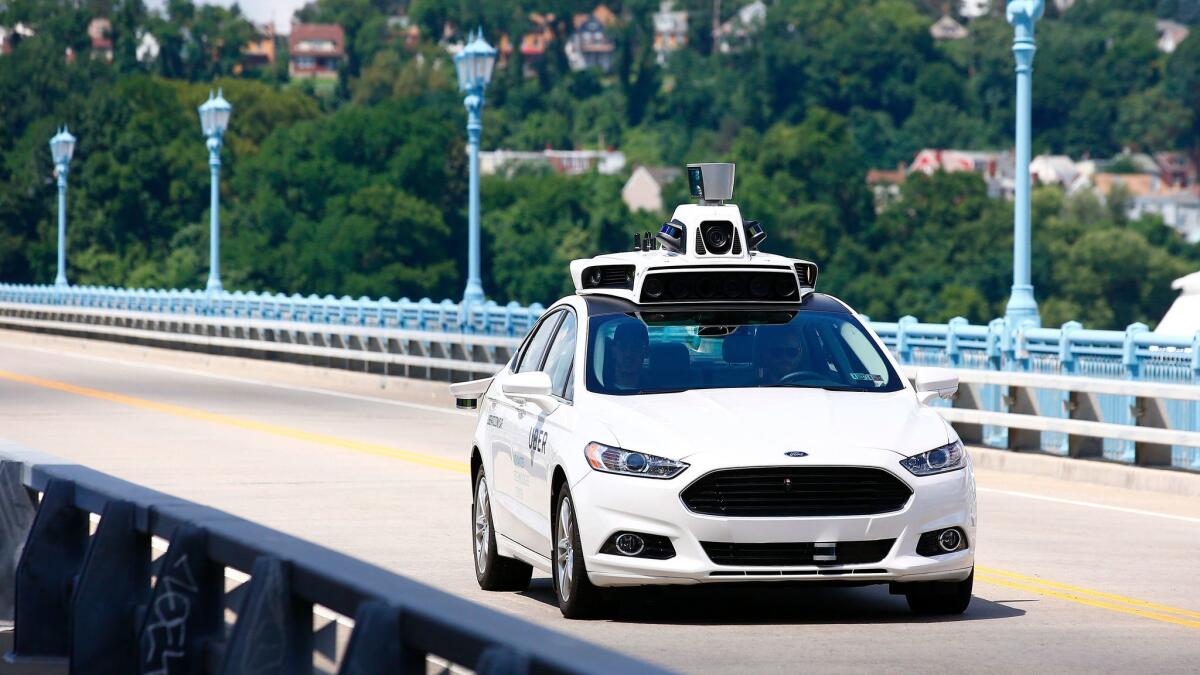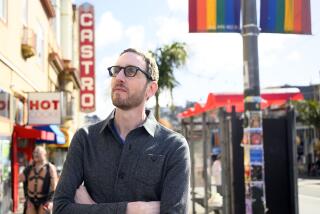California regulations for driverless cars stall as other states speed ahead

This doesn’t look good, Jerry Hill remembers thinking.
He saw the photos online: Uber cars being loaded onto trucks in San Francisco, bound for Arizona. They were new Volvos, test cars bristling with driverless technology.
The robot cars required state permits to operate in California, but Uber refused to apply. Officials ordered them off public roadways in late December. So Uber shipped the cars to a state where such permits aren’t required.
Hill is a California state senator whose district includes most of Silicon Valley. He said he didn’t care for Uber’s nose-thumbing attitude, but did worry that the shipment to Arizona could portray California as anti-innovation, slow and behind the times.
“We’ve been losing a PR battle,” he said.
It wasn’t just Uber. That same month, the state of Michigan passed laws to allow driverless vehicles on the state’s roadways with minimal restrictions — and not just test cars.
The law “allows autonomous vehicles on any road at any time for any reason,” said Kirk T. Steudle, director of the Michigan Department of Transportation. “If you can buy one today, you can operate one in Michigan.”
(You can’t purchase a driverless car yet, because they’re not being sold. But automakers say they’ll put them on the market in just a few years.)
Florida already had passed a similar law. Nevada; Arizona; Washington, D.C.; Pittsburgh and other jurisdictions have implemented regulations, or pointedly avoided doing so, to encourage the development of driverless cars, saying they’ll save lives and create an economic boom.
The California Department of Motor Vehicles, meanwhile, has entered the fifth year of a glacial effort to draw up driverless-car rules, soliciting public opinion on proposed regulations that have sparked controversy and consternation among automakers and driverless-technology companies.
“The draft regulations would erect significant barriers to testing and adoption of autonomous vehicles that do not exist in any other state,” a representative for the Assn. of Global Automakers told DMV officials at a recent public hearing. “We are concerned that the state may be closing the door to innovation.”
How much of that complaint is real and how much is hyperbole is up for debate. But Silicon Valley’s position as the top innovator in a fast-emerging new technology with enormous economic potential and far-reaching social ramifications was being questioned, and that did not sit well with Hill. I’ve got to do something, he told himself.
On Jan. 17, he took a first step, introducing a bill that would require the DMV to immediately accept or reject an application to put a driverless car on the road. The regulations the DMV has proposed, by contrast, would give the agency 180 days — nearly half a year — to decide yes or no.
The bill aims to inject some urgency into the process. “Historically, the DMV has not been the most efficient bureaucracy around,” Hill said.
He also met with Brian Kelly, head of the California State Transportation Agency, which oversees the DMV. He conveyed the concerns of his constituents and asked what could be done to accelerate the process.
Kelly said his department would release detailed, revised regulations in the next four to six weeks and seek public comment on those.
“I do think it’s going to provide certainty to the marketplace,” Kelly said.
The marketplace will be huge, though no one is sure just how big. The Boston Consulting Group estimates a global market of at least $42 billion annually by 2025 for partially and fully autonomous cars — and that’s just for the technology itself. It doesn’t include any of the services that driverless vehicles will boost, including ride-hailing, car-sharing and vehicle subscription services. (Nor does it account for driver jobs lost to automation.)
As the capital of advanced technology, with its critical mass of software and engineering talent, Silicon Valley will continue to play a major role, no matter what the DMV does.
Artificial intelligence, vision systems, lidar sensors, memory chips, app creation, communications expertise, investment capital: The development of everything that goes into a driverless car, other than the car itself, is centered in California.
“There won’t be any wholesale departure of innovation from the state” even with the state’s current proposed rules, said James M. Anderson, researcher and executive at Rand Corp.
But could it allow other states to chip away at California’s leadership? Yes, he said.
The whole thing started in 2012, when the Legislature passed a bill directing the DMV to set such rules. First up were regulations that cover autonomous cars with a human driver behind the wheel to assure safety. A permit for each car was required — that’s the rule Uber was intentionally violating.
The years since have been spent developing guidelines for testing completely driverless cars on public roads, with the DMV issuing its proposals in September.
Exasperated auto industry representatives say those proposals show a preference for process and hoop-jumping instead of for automotive progress.
For instance, the permit process has been panned as too time-consuming and unreasonable. It includes a requirement that the governing body of each local jurisdiction pass an ordinance or a resolution specifically allowing driverless vehicles on its roads. Otherwise, the cars would have to route around it.
“Local authorities do not and should not regulate the operation of a motor vehicle,” said David Strickland, who heads the Self-Driving Coalition for Safer Streets, a lobby group representing Ford, Volvo, Uber, Lyft and Google’s Waymo autonomous car division.
Strickland said he’s especially concerned that California could set a precedent for other states that have not yet passed driverless-car legislation, creating a patchwork of rules “so untenable and unwieldy that it would halt innovation altogether.”
Regulation must “make sense for all 50 states so that it doesn’t create a regulator rock on our shoulders that is difficult to live with,” said Brad Stertz, who heads government affairs in Washington for Audi.
California transportation head Kelly said many of the concerns will be addressed soon when the DMV proposals are revised. “We’re going to be as flexible as we can be” while putting safety first, he said.
Several requests for an interview with Jean Shiomoto, the DMV’s director, were declined.
Testing of driverless vehicles is expanding to other states and around the world. On the day the Michigan legislation was introduced last May, Google announced that it would open a 53,000-square-foot self-driving-car development center in the suburbs outside Detroit.
Autonomous taxis are being tested on public roads in Singapore. Volvo will begin similar tests soon in Sweden and Britain.
“California isn’t the only place this is going to happen,” said Aaron Steinfeld, a robotics researcher at Carnegie-Mellon University in Pittsburgh, where Uber started testing self-driving cars on city streets last summer. As other states pass more liberal regulations on driverless testing, “we’ll see autonomous vehicle research become more diffuse across the country.”
An executive at one automobile company, who asked not to be named for fear of offending the DMV, said he believes that California is in no danger of losing its edge. Still, he said, driverless cars will save lives and California’s proposed regulations mean that the state’s drivers would have access to driverless cars later than others.
“Does California want to be first or second or 10th in driverless-car deployment?” he said.
Not everyone buys the idea that driverless-car technology can be considered safe any time soon.
“The notion that they are today safer than humans is pure myth,” said Steve Shladover at California PATH, a transportation research arm of UC Berkeley. “They’re not even close to the capabilities of human drivers.”
Proponents of autonomous vehicles, including some federal transportation officials, trot out figures that show more than 35,000 traffic deaths a year, 90% of them the fault of human drivers.
Those numbers are tragic, Shladover acknowledges, but statistically, they show that fatal crashes are “astonishingly rare.”
“That’s one fatal crash per 100 million vehicle miles,” he said. “Or about 3.3 million hours of driving.”
Even if the DMV speeds up its rule-making process, and even if it cuts back on its most bureaucratic proposals, no one thinks California will allow unfettered deployment of driverless cars any time soon — Kelly has made clear that innovation will have to be balanced with safety, and said he believes that driverless cars have not yet proved themselves on that count.
So, in effect, an experiment is taking shape, carrying risks and rewards.
By taking a slower approach, California risks a hit to its reputation for innovation, and a marginal loss of potential revenue in an emerging new industry.
Michigan, by getting driverless cars on the roads faster, could boost the state’s reputation as a major center of driverless-car research, development and manufacturing. The risk is that driverless cars might prove less safe than state officials think.
Twitter: @russ1mitchell







